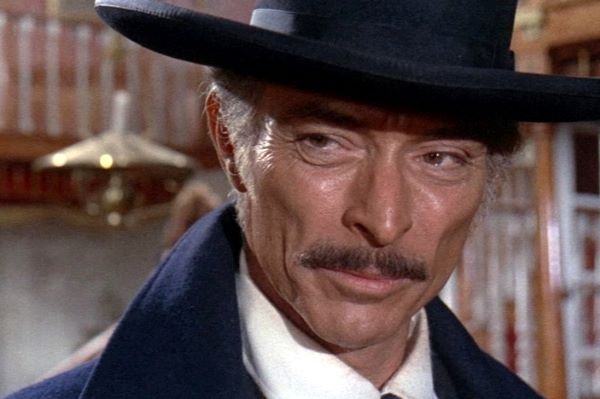If Sergio Leone had moulded the spaghetti western into something approaching high art, then Gianfranco Parolini aimed for more populist delights in the Sabata trilogy, namely the unruly delights of the circus. Lee Van Cleef‘s slightly seedy and entirely amoral gunslinger is as much showman as gun for hire, near supernatural in his skill with both his custom four-barrelled Derringer and modified rifle. He’s surrounded by outlandish allies and villains, some of whom fulfilling both roles.
This is exemplified in the first, and best, adventure Sabata. Blessed with style to spare, an anti-capitalist counter-cultural atmosphere, and a fantastic score from Marcello Giombini, it’s a silly and cynical delight. Sabata takes on the urbanely sadistic landowner Stengel (Franco Ressel) and the corrupt leaders of a Texan town. He’s aided by a slovenly Civil war veteran (Ignazio Spalla) and a mute acrobat (Aldo Canti). William Berger, who Parolini had directed in If You Meet Sartana… Pray for Your Death the year before is a bard whose banjo doubles as a shotgun (likely inspiration for Robert Rodriguez‘ El Mariachi), and who proves as morally flexible as our steely antihero himself. Van Cleef and Berger play off each other superbly and the whole affair has an almost comic book irreverence, right down to every crash zoom into Van Cleef’s narrowed eyes (of which there are many) being accompanied by a hilarious twang like a ruler being pinged against a table. It’s unlikely that Parolini intended to suggest that his leading man was prone to spontaneous erections, but for those used to the see-what-sticks approach adopted by Italian genre filmmakers of the period it adds to the fun rather than detracts. Great stuff all round.
The follow-up Adiós, Sabata was not intended as a Sabata film at all. As is the way with Italian cinema of the period, a film already in production was tweaked to cash in with the success of another franchise. In this case another Parolini enterprise with a different lead character (Indio Black played by Yul Brynner) was hurriedly retitled. The joins are obvious. Brynner, while similarly taciturn, brings a different kind of presence to the role. Sabata here is more of a folk hero with many of Van Cleef’s vulpine edges sanded down.
The film remains hugely enjoyable, filled with Parolini’s familiar idiosyncrasies. Here we have a henchman who spin-kicks lead shot into people’s faces and a dancer whose flashing spurs during his ‘Flamenco of Death’ portend the doom of any who betray Sabata. The plot is fairly unusual too, set as it is in the short-lived Second Mexican Empire under the Austrian archduke Maximilian. This gives Sabata and chums the chance to aid in a plot against a series of comedy aristocratic colonisers with sideburns as big as their imperialistic intentions. This revolutionary air is intensified with the casting of Marxist singer and actor Dean Reed, who made a string of spaghetti westerns before defecting to East Germany in 1973. While it doesn’t quite feel like the real deal Adiós, Sabata remains a very good example of the subgenre and has easily the highest body count of the three films, even if the action becomes a little repetitive. There are only so many ways a shot man can balletically plunge from a roof after all.
Van Cleef was back wielding the Derringer for Return of Sabata, rounding off the trilogy in a caper weirdly more different in tone than its shoehorned predecessor. There’s a surreal, carnivalesque air that throws together knockabout silliness with an overly labyrinthine plot. There’s even an opening sideshow fake-out lit like a Mario Bava giallo. The story sees Sabata squaring up to an Irish family of landowners, who are pilfering the high taxes they’ve imposed in a Texas town they claim are for improvements. As always, it has its acrobats and a handsome frenemy who will alternatively aid or betray Sabata as the story dictates (Reiner Schöne in this instance). Return of Sabata is perhaps best known for being included in Michael Medved‘s infamous 1978 book The Fifty Worst Films of All Time. Even with 43 years of hindsight it’s a ludicrous inclusion. It’s probably the weakest film of the three, but given the rushed output and crowded release schedule at the tail of the spaghetti boom, it is unlikely it was anywhere near the worst in the genre released that year.
Available on Blu-ray now
